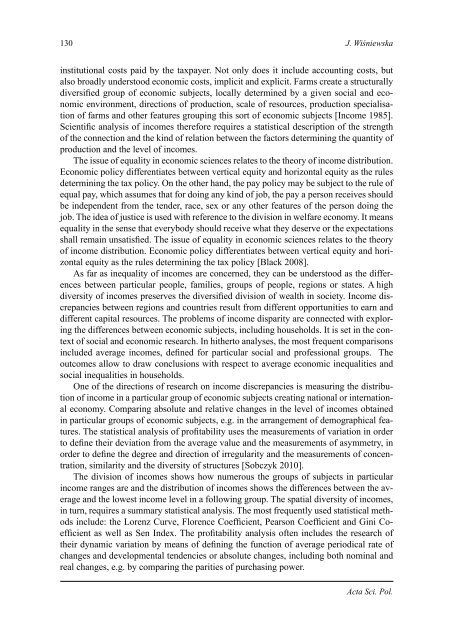ACTA SCIENTIARUM POLONORUM - SGGW
ACTA SCIENTIARUM POLONORUM - SGGW
ACTA SCIENTIARUM POLONORUM - SGGW
Create successful ePaper yourself
Turn your PDF publications into a flip-book with our unique Google optimized e-Paper software.
130 J. Wiśniewskainstitutional costs paid by the taxpayer. Not only does it include accounting costs, butalso broadly understood economic costs, implicit and explicit. Farms create a structurallydiversified group of economic subjects, locally determined by a given social and economicenvironment, directions of production, scale of resources, production specialisationof farms and other features grouping this sort of economic subjects [Income 1985].Scientific analysis of incomes therefore requires a statistical description of the strengthof the connection and the kind of relation between the factors determining the quantity ofproduction and the level of incomes.The issue of equality in economic sciences relates to the theory of income distribution.Economic policy differentiates between vertical equity and horizontal equity as the rulesdetermining the tax policy. On the other hand, the pay policy may be subject to the rule ofequal pay, which assumes that for doing any kind of job, the pay a person receives shouldbe independent from the tender, race, sex or any other features of the person doing thejob. The idea of justice is used with reference to the division in welfare economy. It meansequality in the sense that everybody should receive what they deserve or the expectationsshall remain unsatisfied. The issue of equality in economic sciences relates to the theoryof income distribution. Economic policy differentiates between vertical equity and horizontalequity as the rules determining the tax policy [Black 2008].As far as inequality of incomes are concerned, they can be understood as the differencesbetween particular people, families, groups of people, regions or states. A highdiversity of incomes preserves the diversified division of wealth in society. Income discrepanciesbetween regions and countries result from different opportunities to earn anddifferent capital resources. The problems of income disparity are connected with exploringthe differences between economic subjects, including households. It is set in the contextof social and economic research. In hitherto analyses, the most frequent comparisonsincluded average incomes, defined for particular social and professional groups. Theoutcomes allow to draw conclusions with respect to average economic inequalities andsocial inequalities in households.One of the directions of research on income discrepancies is measuring the distributionof income in a particular group of economic subjects creating national or internationaleconomy. Comparing absolute and relative changes in the level of incomes obtainedin particular groups of economic subjects, e.g. in the arrangement of demographical features.The statistical analysis of profitability uses the measurements of variation in orderto define their deviation from the average value and the measurements of asymmetry, inorder to define the degree and direction of irregularity and the measurements of concentration,similarity and the diversity of structures [Sobczyk 2010].The division of incomes shows how numerous the groups of subjects in particularincome ranges are and the distribution of incomes shows the differences between the averageand the lowest income level in a following group. The spatial diversity of incomes,in turn, requires a summary statistical analysis. The most frequently used statistical methodsinclude: the Lorenz Curve, Florence Coefficient, Pearson Coefficient and Gini Coefficientas well as Sen Index. The profitability analysis often includes the research oftheir dynamic variation by means of defining the function of average periodical rate ofchanges and developmental tendencies or absolute changes, including both nominal andreal changes, e.g. by comparing the parities of purchasing power.Acta Sci. Pol.
















